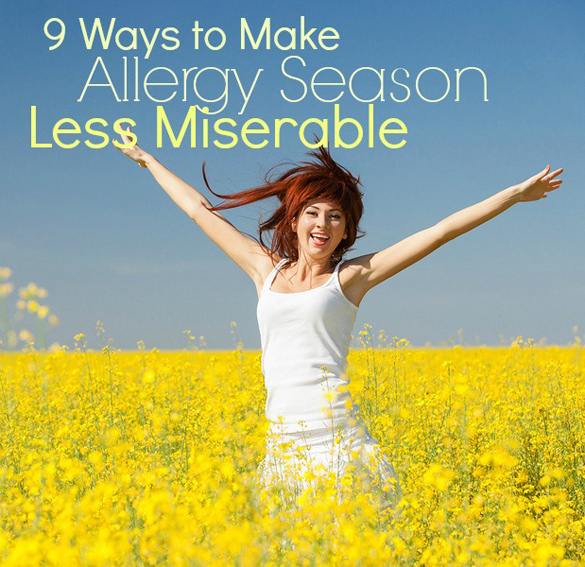9 Ways to Make Allergy Season Less Miserable
I haven’t noticed my allergies much this spring. They’re hiding behind two of the worst colds I’ve ever had. Both of the colds had the rest of my family sniffling for a day or two, but they knocked me out. My superhuman immune system of my two previous pregnancies is clearly on vacation, and the viruses have had me down for the count. Being up all night coughing isn’t exactly the ab workouts I had in mind for this pregnancy.
But usually, this time of year has me suffering from mild sniffling, sneezing and watery eyes. Most of us run to the drugstore to stock up on antihistamines, but there are some lesser-known tricks and tips to reducing allergies and making allergy season more tolerable. Robin Wilson, an ambassador for the Asthma and Allergy Foundation of America, offers up some tips to reduce the symptoms like sneezing, stuffy or runny nose and itchy eyes, as well on how to allergy-proof a kid’s room!

9 Ways to Make Allergy Season Less Miserable
1. Consume local honey. The idea behind eating local honey made by local bees is kind of like gradually vaccinating the body against allergens. Local honey contains the same pollen spores that give allergy sufferers so much trouble when flowers bloom. Introducing these spores into the body in small amounts by eating honey may make the body accustomed to their presence and decrease an immune system response. Even a major resort in Austin, Texas, The Omni Barton Creek, produces its own honey and gives it to guests to help them fight local allergies.
2. Fruit is not always your friend. Many of our favorite fruits, from apples and bananas to peaches and plums, can cause symptoms similar to grass or tree pollen reactions. If you are sensitive, place the fruit in the microwave for 10 seconds to deactivate the proteins, and never eat the peel.
3. Caution with sunscreen. We’re told to lather up in sunscreen when going outside for extended periods of time, especially during allergy season, when the sun is the strongest. But unfortunately, not only will the outdoor pollen get you wheezing, sneezing and itching, so too can that sunscreen. Always look for products that contain zinc oxide and titanium dioxide to reduce your chances of a photoallergic reaction.
4. There’s no such thing as a hypoallergenic dog. Thinking of getting a dog this summer? There really is no scientific proof of a hypoallergenic breed. Avoid exposure to pets, never allow them on the bed and always wash your hands thoroughly with soap and hot water after playing with an animal. Keep them bathed often to reduce dander.
5. Pick non-VOC paints. Summer is a great time to paint the house or a room. Always use non-VOC paints which won’t off-gas, leave an obnoxious paint odor and stir up allergies. It looks just as good on the wall as regular paint.
6. Change your pillow. If your pillow is older than three years and has not been washed, it weighs more now than when you bought it. It’s loaded with dust mites that are next to your face while you sleep. Use hypoallergenic pillows over down pillows, and use a zippered pillow protector that you wash weekly for a double barrier. Wash your pillow twice a year and replace pillows every three years. (Robin has a line of hypoallergenic pillows and comforters at Bed, Bath & Beyond.)
7. Always use a nylon shower curtain liner. Allergy sufferers are told to shower often to remove pollen and pet dander from their bodies. But the phthalate chemicals in vinyl shower curtains off-gas with humidity and heat, and also attract mold and mildew. Replace your vinyl liner with a nylon shower curtain liner.
8. Kids and allergies. Small children can exhibit signs of allergies through wheezing, clear runny nose and rubbing nose/ears/eyes as a reaction to a trigger. It is always best to document the symptoms, and consult your pediatrician.
9. Allergy-proof a room. Allergy proof a child’s room by minimizing clutter, dusting/vacuuming weekly and changing bed linens weekly. Use hypoallergenic pillows and comforters. Plus, use carpet tiles (I recommend FLOR Carpet Tiles) or rugs instead of wall-to-wall carpet. Use low-to-no VOC paints on walls so that there is no paint smell (off-gassing) one hour after you paint. Although children love stuffed toys, keep them to a minimum. Freeze them for 24 hours to kill dust mites and other bacteria.
Thanks for the tips, Robin! Hopefully my sinus infection will clear up and I can actually test these tips out! And I just might use No. 9 as an excuse to get rid of a few stuffed animals … —Erin
